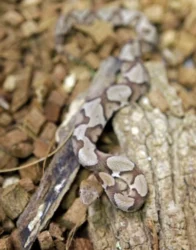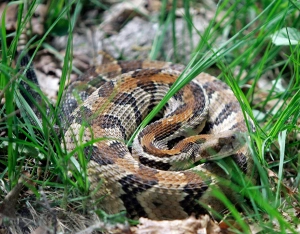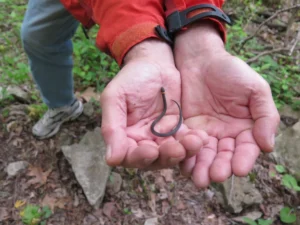IT’S BABY COPPERHEAD SEASON – USE CAUTION AROUND VENOMOUS SNAKES IN EAST TN
KNOXVILLE, Tenn. (WATE) — With it being baby Copperhead season and the weather beginning to cool down, more caution is being given when looking out for snakes who may be hiding nearby.
While a common first reaction to seeing a snake is fear, there are only two types of venomous snakes in East Tennessee according to the Tennessee Wildlife Resource Agency. Aside from these snakes, there are at least 20 more recorded in the region, and these critters help keep the ecosystem in check.
Each of these snakes has different diets, although some include small prey like earthworms, grubs, and insect larvae to more known diets including eggs, rodents, birds, small fish, frogs, lizards, and other snakes.
Snakes have an interesting role in the ecosystem, the University of Illinois College of Veterinary Medicine explains. While snakes control pest populations, they also serve as prey for other species. In fulfilling these roles, the College of Veterinary Medicine says that snakes maintain the biodiversity of Earth.
The two venomous snakes in East Tennessee are Copperheads and Timber Rattlesnakes according to the TWRA. Both of these snakes are brown and have pretty distinctive markings, although it is a good idea to be cautious around any snake that cannot be identified for certain.
Copperheads are medium-sized snakes according to TWRA, reaching between 2-3 feet long. What makes these snakes identifiable is their coppery head, dark brown hourglass shape, and triangular-shaped eyes. Despite what some might think about the name, their body color is variable, although it is typically a light brown or gray according to TWRA. Some noticeable other distinctions are their facial pits on either side of their head between their eye and nostril, scales that are keeled (have a ridge running down the middle), and some young Copperheads also have bright yellow tails.

A copperhead snake looks up at the Nature Museum in Charlotte, N.C., Tuesday, Aug. 17, 2010. (AP Photo/Chuck Burton)
These snakes like to live in a more forested habitat rather than open areas as they like rocky, wooded hillsides with plenty of logs, leaf litter, or rocks for cover according to TWRA. They have an interesting diet, consisting largely of mice, but also including birds, lizards, snakes, amphibians, and insects, TWRA says, especially cicadas.
The other venomous snake to watch out for is the Timber Rattlesnake. While it is one of two rattlesnakes found in Tennessee, the Pygmy Rattlesnake, which is much smaller and more colorful, lives mainly around the Kentucky lake and Tennessee River. The Timber Rattlesnake, however, is found statewide and is a large, heavy-bodied snake according to TWRA. It ranges between 3 to 5 feet when it is grown, and while the body color is variable, most have a rust-colored line down the center of the back and black or dark chevron pattern crossbands along the body.

A timber rattlesnake sits coiled on section of a trail in Mountaintown, Ga., Wednesday, May 23, 2007. (AP Photo/John Bazemore)
A distinctive feature of the snake is its rattle at the end of its tail, although other snakes are known to shake their tail when frightened as a defensive mechanism. Newborn rattlesnakes have a single segment, called a button, on their rattle, and each time the snake sheds its skin, another segment is added to the base of the tail according to TWRA. If the rattle isn’t visible, the snake’s markings as well as the shape of its triangular head and thick body are good identifiers to look out for. Like the Copperhead, it also has a pit on each side of its face between the eye and nostril.
These snakes often live in mature and heavily wooded forests according to TWRA, with rocky south-facing hillsides often associated with bluffs or ledges. TWRA says they also can be found around mountains, swamps, cane thickets, wooded stream corridors, or rural habitats, and they like to coil up near fallen logs or sun on rocks.
These snakes usually eat small rodents, like mice, rats, chipmunks, and squirrels according to TWRA, although they may also occasionally eat birds, lizards, and other small mammals.
Other snakes that you might find in East Tennessee include Worm Snakes, Scarlet Snakes, the North American Racer, Ring-necked Snakes (pictured below), Red Cornsnakes, Grey Ratsnakes the Eastern Hog-nosed Snake, Yellow-bellied and Common King Snakes, Queensnakes, Milk Snakes, Norther Watersnakes, Rough Greensnakes, Pinesnakes, DeKay’s Brownsnakes, Red-bellied Snake, Southeastern Crowned Snake, Eastern Ribbonsnakes, Common Gartersnakes, and Smooth Earthsnakes.

This April 25, 2015 photo shows Doug MacMillan of San Diego, Calif., holding a young ring-necked snake in his hands after finding the hatchling beneath a rock in southern Illinois, Shawnee National Forest.
One of the cutest snakes that live in the region was the Worm Snake, which TWRA says reaches only 7.5-10 inches long when it is fully grown. The small, iridescent snake has small pointed eyes and lives mostly underground or under cover. The Eastern Worm Snake can be found in the Great Valley and Unaka Mountains of East Tennessee, while the Midwestern Worm Snake can be found across the rest of the state according to TWRA.
To learn more about these snakes, visit the TWRA’s website.





